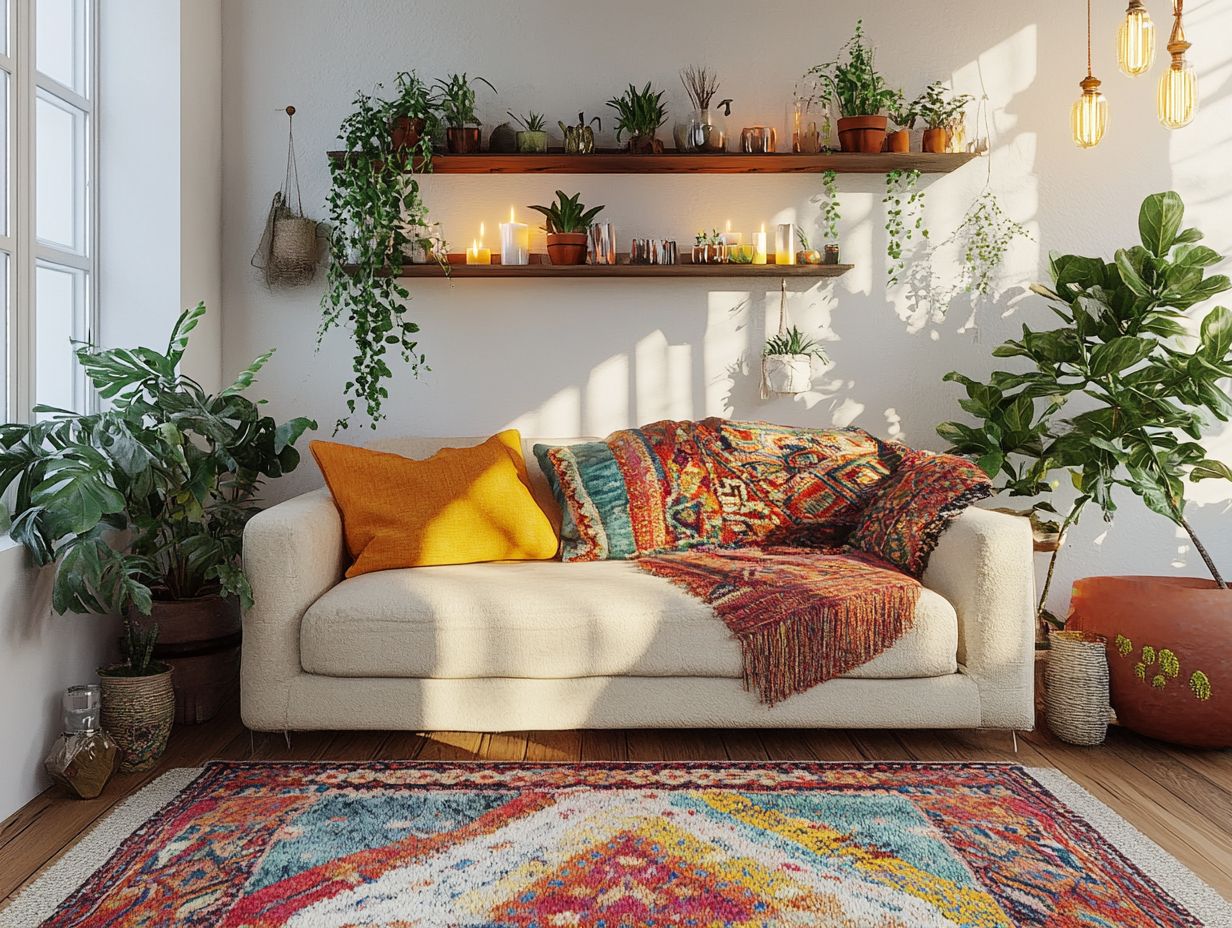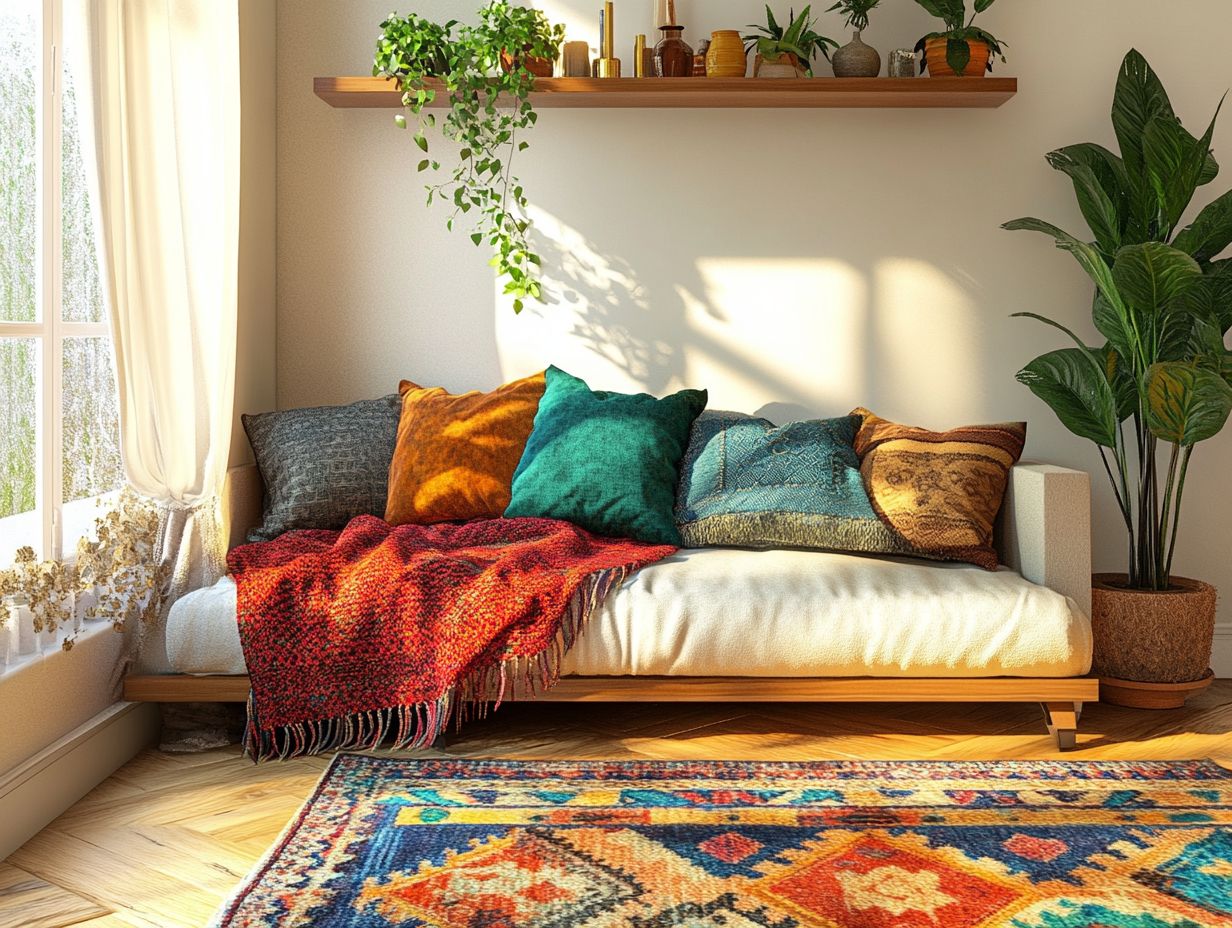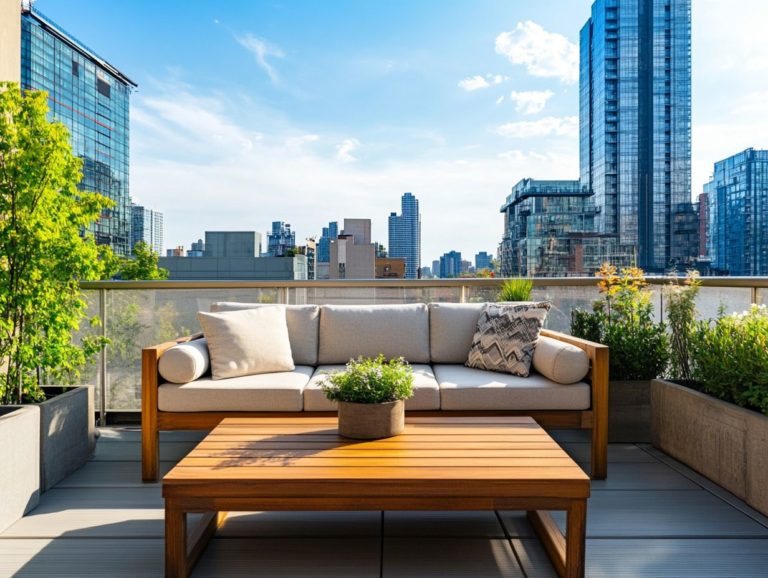What Are the Best Decorative Elements for Small Spaces?
Maximizing space in small areas may seem like a daunting challenge, but it opens the door to creativity and style in interior design.
In this article, you ll explore effective strategies for space maximization to make your compact spaces feel larger and more inviting. From choosing multi-functional furniture to clever mirror placement, you ll learn how to utilize every inch wisely.
You ll also delve into the psychology of color and discover the impact of personal touches that reflect your unique personality.
Are you ready to transform your compact living area into a stylish haven?
Contents
- Key Takeaways for Small Room Ideas:
- Challenges and Benefits
- Maximizing Space with Furniture
- Using Mirrors and Lighting to Create Illusions of Space
- Incorporating Vertical Space
- Choosing the Right Color Scheme
- Adding Personal Touches with Decorative Elements
- Frequently Asked Questions about Decorating Small Spaces
- What Are the Best Decorative Elements for Small Spaces?
- Why are mirrors a good decorative element for small spaces?
- How can floating shelves be used as a decorative element in small spaces?
- What makes multi-functional furniture a good choice for small spaces?
- How can vertical storage solutions be utilized in small spaces?
- Why is lighting important when it comes to decorating small spaces?
- What types of plants work well as decorative elements in small spaces?
Key Takeaways for Small Room Ideas:

- Use multi-functional and space-saving furniture to maximize space in small areas, like a storage ottoman as a coffee table or a Murphy bed that also serves as a desk.
- Place mirrors and lighting strategically to create the illusion of more space. Opt for wall-mounted mirrors and bright, natural lighting for the best results.
- Incorporate vertical space with wall shelves and hanging plants to add functionality and storage solutions.
Challenges and Benefits
Navigating the realm of small room ideas presents a variety of design challenges that can significantly influence both the aesthetics and functionality of compact spaces. Renowned interior designers James Thurstan and Irene Gunter illustrate that embracing these challenges can yield remarkable benefits, leading to innovative solutions that transform even the most minuscule areas into welcome living spaces.
Hone in on efficient designs, utilize clever lighting, and arrange furniture strategically to maximize space while cultivating a warm and inviting atmosphere.
Maximizing Space with Furniture
Maximizing space with furniture requires a thoughtful approach to placement and selection, enhancing both functionality and style. This is particularly crucial in smaller rooms where every inch is precious.
Designers such as Ruth Mottershead and Edward Bulmer champion the use of multi-functional furniture that serves various purposes, enabling you to navigate your space effortlessly.
By arranging your furniture wisely, you can create an illusion of spaciousness, transforming compact areas into inviting, open environments.
Multi-functional and Space-saving Pieces
Multi-functional and space-saving pieces are essential for achieving an efficient layout in small rooms, offering versatility without compromising style. Consider items like sofa beds, extendable dining tables, and nesting tables. They provide the utility you need while enhancing the aesthetic of compact spaces.
Incorporating these clever solutions can transform cramped quarters into inviting and functional living areas, ideal for cozy living. For example, a chic ottoman that doubles as storage helps you declutter your living room while providing extra seating. Wall-mounted desks create dedicated workspaces that don t occupy valuable floor space, allowing you to transition seamlessly from work to relaxation.
Modular shelving units can be reconfigured to meet your evolving needs, offering both display and organizational elements. By thoughtfully integrating such innovations, you can maximize your living space, crafting an atmosphere of stylish comfort that feels both spacious and welcoming.
Using Mirrors and Lighting to Create Illusions of Space
Employing mirrors and thoughtful lighting is an exceptional strategy in interior design, especially in smaller rooms, where the illusion of space can be expertly crafted.
Designers like Sheena Murphy harness reflective surfaces and strategic lighting to amplify natural light, transforming compact areas into open and airy havens.
Choose the right mirrors and lighting fixtures to cultivate a dynamic atmosphere that promotes spaciousness while embodying elegance and style.
In conclusion, maximizing your small space is all about smart choices in furniture, lighting, and decor. Implement these strategies to create a beautiful and functional living area that reflects your personality. Don t forget to share your own tips and follow us for more exciting ideas!
Strategic Placement and Types of Mirrors and Lighting

The strategic placement of mirrors and the artful use of lighting can significantly transform small rooms, giving them depth and brightness that enhances the overall design.
By selecting the right types of mirrors whether oversized or decorative and incorporating layered lighting, you can achieve a perfect blend of functionality and style.
Position mirrors across from windows or other light sources to bounce natural light throughout the space. This creates an open and airy feel.
Combining ambient lighting (the main light in a room), task lighting (for specific activities), and accent lighting (to highlight certain areas) can craft a versatile atmosphere. This enables the room to shift effortlessly from functional to cozy.
Consider adding sconces and pendant lights above mirrors; this amplifies the effect, enhancing visual interest while ensuring an even distribution of light. These thoughtful design choices not only elevate aesthetics but also maximize perceived space, creating a more inviting environment.
Incorporating Vertical Space
Incorporating vertical space into your interior design can transform small rooms. This enables you to utilize every inch effectively while maintaining a stylish atmosphere.
By integrating elements such as wall shelves and hanging plants, you can create visual interest and maximize storage in compact areas.
This approach enhances functionality and infuses a sense of quiet luxury into your space, making it feel larger and more inviting.
Wall Shelves, Hanging Plants, and Other Ideas
Wall shelves and hanging plants are your secret weapons for maximizing vertical space in small rooms, blending utility with aesthetic charm.
Carefully selecting their placement and style can transform your space into an inviting haven while gaining essential storage.
Incorporating wall shelves at varying heights creates a dynamically visual effect, efficiently organizing your books, decor, or cherished items.
If you lean towards a bohemian vibe, consider using climbing plants suspended in macram hangers; they will infuse a refreshing touch of nature indoors, softening the room’s edges and adding delightful texture.
Choosing floating shelves in light-colored wood can elevate your space, enhancing a sense of openness that makes even the coziest nooks feel more expansive.
Placing these shelves strategically near windows allows for optimal sunlight, promoting plant growth and fostering an organic connection with the outdoors. This ultimately enriches the room’s decor and ambiance.
Choosing the Right Color Scheme
Choosing the right color scheme is essential when designing small rooms. Colors can create visual tricks that significantly influence how spacious a room feels.
Designers often recommend opting for lighter hues to reflect light and enhance that coveted sense of openness.
Meanwhile, strategically incorporating bold colors can add visual interest and depth, especially in cozy living areas where every detail counts.
Visual Tricks and Color Psychology
Visual tricks and color psychology are pivotal in shaping your perception of space within small rooms. They significantly impact both your mood and spatial awareness.
By opting for lighter colors and specific patterns, you can manipulate visual perceptions, making areas feel larger and more inviting.
Consider wall treatments with horizontal stripes; they create the illusion of width, making a narrow room appear more expansive.
Warm hues like soft yellows or pastel greens can evoke feelings of tranquility, ensuring that the space feels cozy rather than cramped.
Strategically incorporating mirrors can also amplify light and open up tight areas, enhancing the perception of depth.
Thoughtful color choices and visual tricks not only transform aesthetics but also elevate the overall atmosphere, demonstrating how design can profoundly influence your everyday living experience.
Try these tips today and watch your small space come alive!
Adding Personal Touches with Decorative Elements

Incorporating personal touches through decorative elements like small art pieces and plants is crucial for crafting a unique and inviting atmosphere in your small rooms. For more insights, check out the best way to decorate a tiny house.
These thoughtful additions showcase your individual style. They elevate the overall aesthetic, transforming compact spaces into warm and welcoming havens that truly feel like home. Let s explore how to make your spaces truly shine!
Small Art Pieces, Plants, and Other Accents
Small art pieces, plants, and decorative accents can make your cozy spaces look better. They add texture and personality. By thoughtfully selecting items and exploring the best ways to personalize tiny spaces, you can craft living areas that feel both personal and stylish.
Incorporating these elements strikes a perfect balance between functionality and design, turning limited spaces into visually captivating environments. Small art pieces, whether framed photographs or abstract designs, can serve as focal points, drawing the eye and infusing a sense of individuality. Meanwhile, plants not only purify the air but also introduce a breath of nature, making your rooms feel more inviting.
Together, these accents also create a unified look, transforming ordinary settings into unique havens that truly reflect your character and taste.
Frequently Asked Questions about Decorating Small Spaces
What Are the Best Decorative Elements for Small Spaces?
There are several decorative elements that work well in small spaces, such as:
- 1. Mirrors
- 2. Floating shelves
- 3. Multi-functional furniture
- 4. Vertical storage solutions
- 5. Lighting
- 6. Plants
Why are mirrors a good decorative element for small spaces?
Mirrors can create an illusion of more space by reflecting light and making a room appear larger. They can also add visual interest and depth to a small space.
How can floating shelves be used as a decorative element in small spaces?

Floating shelves take up minimal space and can be used to display decorative items while also providing storage. They are a great way to add personality to a small space without taking up valuable floor space.
What makes multi-functional furniture a good choice for small spaces?
Multi-functional furniture, such as a storage ottoman or a sleeper sofa, can serve multiple purposes and help maximize the use of space in a small room. These pieces are also great for small spaces because they can be easily moved or stored when not in use.
How can vertical storage solutions be utilized in small spaces?
Vertical storage solutions, such as hanging shelves or wall-mounted organizers, can free up valuable floor space and help keep a small room organized. They are also a great way to make use of empty wall space.
Why is lighting important when it comes to decorating small spaces?
In small spaces, lighting can play a crucial role in creating the illusion of more space. Natural light can make a room feel bigger, while strategic placement of artificial lighting can help highlight specific areas and add depth to a small space.
What types of plants work well as decorative elements in small spaces?
Plants can add a touch of nature and color to a small space, but some varieties are better suited for compact areas. Succulents, air plants, and small potted herbs are great options for adding greenery without taking up too much space. Hanging plants are also a great way to add visual interest without taking up valuable surface space.






